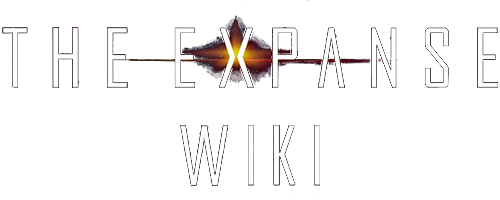Earth, also known as Terra or Sol Ⅲ, is the third planet of the Sol system, and one of its four terrestrial worlds. Homeworld of humanity, Earth is the greatest hub of human politics and, technically, still the capital planet and the dominant superpower, with its governing body the United Nations. It has always been at the forefront of human history.
History
Interplanetary colonization
By the mid and late 21st century, humanity's national governments, under the auspices of the United Nations, then simply a supranational organization, but with considerably more power than at its inception, had begun to establish colonies on the other planets in the Sol system, the most notable of these being Luna and Mars. However, after continuous success and because of the precarious state of Earth's ecosystem due to extensive pollution, the nations decided to relinquish their national governing rights and make the UN into a global, unified government.
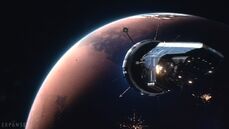
Solomon Epstein's drive technology allowed for Mars to secede and achieve its independence.
Eventually, in the 23nd century, the colonial government that administered humanity's first colony demanded that they be independent. The United Nations, reticent to cede their control over Mars, refused. It was only thanks to Solomon Epstein Books • TV and his groundbreaking invention, the Epstein drive, that war was avoided. The colonial government offered the UN access to the revolutionary drive in exchange for independence. To avoid Mars having a tactical advantage, the UN agreed.
For the next century and a third, the United Nations and its newly proclaimed rival, the Martian Congressional Republic (MCR), often competed over living standards, technology, and military strength. However, no true conflict erupted between the two superpowers, and relations kept a decent level of cordiality. After both nations had access to the drive and were able to mass-produce it, humanity expanded beyond the confines of the inner Sol system and began establishing outposts on asteroids of the Asteroid Belt, such as Eros and Ceres, eventually reaching the moons of the gas giants, such as Io, Ganymede, Europa, and more distant ones, such as Titan and Titania.
UN-MCR Cold War
Until the discovery of the Protomolecule roughly eight years prior to the Eros incident Books • TV, the UN and the MCR remained neutral one towards the other, but continuously oppressed their colonies' inhabitants in the Belt and outer planets. Small insurrections started taking place but were quickly stifled. This authoritarian process continued, which led to the formation of the Outer Planets Alliance, a multi-movement organization that sought the independence of the Belt and outer planets from Earth. Called 'terrorist' by both Mars and Earth, the organization saw itself as opposed by the two superpowers. Eventually, through Tycho Station, Fred Johnson Books • TV, a former United Nations Marine Corps (UNMC) marine, became the OPA's de facto leader and spokesperson.
Around the mid-24th century, the Martian government issued a project regarding the exploration and eventual exploitation of Phoebe for raw materials, mostly water. Their finding there prompted Mars to prolong research regarding the Saturn moon, establishing a decently large laboratory. They sought partnership with Protogen, a mega-corporation owned by Jules-Pierre Mao Books • TV. Ultimately, they concluded that the pathogen found there - in the meantime dubbed the Protomolecule, or the 'Phoebe bug' - was extra-solar in origin and must have been implanted there by an alien civilization. The Martian government saw this as an opportunity to finally gain the upper hand over the UN.
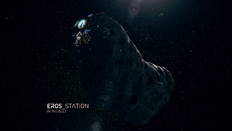
The Eros incident marked a major shift in UN policy and the geopolitics of the system.
After a series of events involving Julie Mao Books • TV, the eldest daughter of Jules-Pierre, the Protomolecule was let loose on Eros station, killing 100,000 people. The biomass of the victims was absorbed by the alien pathogen, which then began manipulating gravity at the quantum level and launched Eros towards Earth. Hysteria quickly spread through the planet's population, while governmental officials were already evacuating to Luna. Eventually, thanks to former detective Josephus Miller Books • TV, human extinction on the planet was avoided, with Eros ultimately impacting Venus instead of humanity's home-world.
A relatively short amount of time later, marines of the United Nations Marine Corps and the Martian Marine Corps were attacked by a human-protomolecule hybrid on Ganymede. The incident on the ground escalated into full engagement in orbit around the Jovian moon as the Ganymede incident Books • TV. Thousands of residents lost their homes, while others had to leave the station as refugees to other human settlements across the system. Following the incident, the UN issued a research project regarding Eros' impact crater into Venus by sending the scientific vessel UNS Arboghast.
Opening of the Sol Ring
The later death of the remaining human-Protomolecule hybrids determined the Protomolecule to launch a 1,000-km wide Ring two astronomical units outside of Uranus' orbit. The Ring proved to be an artificially sustained usable wormhole, capable of transporting ships to a hub of other Rings, each leading to one of 1,373 new systems. This enlarged humanity's horizons, finally uplifting the species to the interstellar scale.
Interstellar expansion
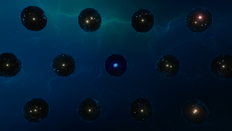
The opening of the Ring network allowed millions of Earth's population to seek a better life as colonists.
The United Nations sent multiple probes to other systems, pursuing the existence of a habitable planet for humanity to colonize. Eventually, Ilus was found to be a suitable candidate. Unbeknownst to Earth's government, the planet was already populated by Ganymede refugees. The UN gave the rights of colonization and exploitation to the Royal Charter Energy, but the company was unsuccessful. It took James Holden Books • TV and his crew's methods for the situation to come to a resolution.
Following the colonization of Ilus, the United Nations began sending multiple colony ships through the Ring gates to colonize other planets in other systems. In a relatively short period of time, humanity had a decent number of interstellar colonies, having expanded more in a decade than it did in two hundred years. Prior to the ignition of the Free Navy Conflict, the colonies, Earth, and Mars had a relatively tension-less relationship.
Bombardment of Earth
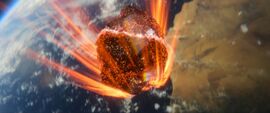
The first stealth-coated asteroid enters the atmosphere above West Africa.
A few years after the Conflict on Ilus, a radical group known as the Free Navy, led by Marco Inaros Books • TV, who, in turn, received commands from a rogue MCRN Admiral Winston Duarte, launched an offensive on Earth and Mars simultaneously. Before the UN and its allies could repel the invading fleet, Earth was left crippled with the Bombardment of Earth Books • TV, a devastating attack of MCRN stealth technology-coated asteroids launched at the planet, killing millions and destroying regions in North America, West Africa and South Asia. UN command moves off world to Luna with the devastation of UN headquerters and the death of Secretary General Nancy Gao.
Ovever the next six month all of the UN Navy forces were pulled back to Earth to protect it from the continues rocks that are thrown towards the Planet by the Free Navy. The environmental effects from the impacts started to deterioate the planet's environemnt and ecology leading it to be the deadliest war in human history. Eventually, the rocks being thrown at the planet were halted and this freed the Consolidated fleet to fight and defeat the Free Navy, but at costs deemed not worth perceiving. Even after the war, Earth remained ecologically devastated and its effects were still notable decades after.
Laconia-Sol Conflict
A recovered Earth thirty years after the Free-Navy conflict faced a new threat during the Laconia-Sol Conflict. When the self-isolated Laconia system suddenly emerged to take control of the slow zone Books • TV and Medina Station Books • TV. The now named Laconian Empire then shifted their sights to take the Sol system. This was however met with resistance by the Earth-Mars Coalition and Transport Union who were attempting to defend their system. Following this, Laconian military representatives sent their Magnetar-class battlecruiser, the Heart of the Tempest to take control. This conflict was however short-lived when the Tempest single handedly slaughtered the opposing forces fleets. Following this defeat, the UN surrendered to the Laconian Empire and the balance of power shifted away from the Sol System for the first time in the history of humanity.
Under Laconian rule
Four years into the rule of the Laconian Empire, the UN is no longer in power and a Lacoian governor is installed to run the planet while the Tempest stays in orbit to keep the system in check.
Battle for the Ring Station
Following the Battle for the Ring Station, the destuction of the Ring network and the Sol gate, Earth and the rest of the Sol System is cut off from the Intersteller human community. A thousand years later Marrel Imvic and the crew of the Musafir from the Dobridomov system arrive to Earth with the use of a new intersteller drive. They are the first to land on the ancestral home of all the Thrity worlds and make contact with Earthers.
Living standards and civilian life
Pre-bombardment
In the 24th century, prior to the Bombardment of Earth, the planet faced extreme scarcity and relied heavily on resources provided from the Belt to run its global economy. The combined population of Earth and its colonies stood at 31 billion citizens, and there were far more people than available jobs.
Anyone who could not apply for a job had the option of either enrolling in a governmental educational institution (commonly abbreviated as GEI), or living off of the UN welfare system known as Basic Assistance. Over half of Earth's population lived on Basic.
When an individual applied to a government educational institution, that individual was required to have a minimum of one year's worth of work credits in order to apply. This was mandatory to ensure that classroom space is not wasted on individuals without work discipline and lack of ambition.
Melting of the polar ice caps from prior Global warming, had led to a significant rise in sea level by more than 20 metres.
Earth's society is highly stratified. With more than 30 billion inhabitants, resources are scarce and there are simply not enough jobs for everyone on the planet. Although many Earth corporations and the United Nations itself are extremely wealthy, much of the planet’s population lives in severe poverty. Broadly, Earth’s citizens can be divided into two groups: those with jobs and those on Basic Assistance. The employed drive the economy, both with their purchasing power and their surplus production, which supports the rest of the planet’s population. The simple fact that they have currency is a mark of both status and social class.
Nevertheless, there are still sharp divisions among the employed based on just how much money they have. The extremely wealthy live and shop in their own enclaves, and private security ensures they never have to mingle with low or middle-income earners, much less anyone else. Those with jobs have access to high-quality food and medical care, the ability to purchase land and property, and the right to have children, provided they can afford the license and taxes to do so. Instituted by the United Nations in an attempt to curb Earth’s overpopulation, the so-called “baby tax” is prohibitively expensive, so it is not unheard of for groups of people to form civil unions or family co-ops where multiple parents share the tax burden (and even DNA) for one child. It is, of course, possible to have children without paying the baby tax, though only if one relies on the black market and unlicensed doctors, or wins one of the few opportunities for exemption each year.[3]
Post-bombardment
The Bombardment of Earth from the Free Navy at the beginning of the Free Navy Conflict left the planet's infrastructure and environment crippled, with many residents, including officials of the UN government, resorting to immediate evacuation.
In the wake of the Free Navy Conflict, a part of Earth's inhabitants chose to return to the planet and begin the rebuilding process. However, the population afterward was half of what it once was.
30 years after the conflict, Earth had recovered from the devastation it received and had finally opened its doors for trade. The power it once held over all of humanity however then came to an end after being defeated in the Laconia-Sol Conflict.
Human geography
Locations
| Location | Type | Notes |
|---|---|---|
| New York City | City | Federal capital of the United Nations, hosts the nation's government and military centers, mainly the UN Secretariat with the Secretary-General, his cabinet government, and the General Assembly legislature. Also the location of the embassy of the MCR to the UN.
Before the global unification, New York served as headquarters of the United Nations Secretariat and General Assembly, then supranational organizations. |
| The Hague | City | Headquarters of the UN civil administration and the principal nucleus of the judicial branch. |
| Baltimore | City | Birthplace of Amos Burton Books • TV. |
| Copenhagen | City | |
| Kano | City | Elvi Okoye Books • TV studied there at the Kano University of Science and Technology. |
| Abuja | City | |
| Paris | City | |
| Cedar Rapids | City | Birthplace of UNN Lieutenant Jordaan Nemeroff. |
| Saint Petersburg | City | Home of Anna Volovodov Books • TV. |
| Boston | City | Klaes Ashford Books • TV studied at the Lunar campus of the Boston University. |
| Tel Aviv | City | Paolo Cortázar Books • TV studied there at the Tel Aviv Autonomous University. |
| Montana | Region | Birthplace of James Holden Books • TV. |
| Gulf of Denmark | Region | Location of Copenhagen. |
| Yukon Archipelago | Region | Location of Anchorage Island, home of Franklin DeGraaf and Craig. |
| The Pit | Maximum security penitentiary | Officially the Chesapeake Maximum Security Correctional Center (C.M.S.C.C.), Clarissa Mao Books • TV was imprisoned there after the slow zone incident Books • TV. |
| Winnipesaukee Island | Residential enclave | Location of various summer residences of wealthy Earth families, site of the gun battle in Winnipesaukee. |
| Earth administrative zones | UN administrative division |
Urban centres and socio-economics
With such a high population, most of Earth’s citizens congregate in its teeming cities, which sprawl across the planet’s surface. At one time, the Urban Arcology movement attempted to address Earth’s overpopulation problem by building vast structures to house dense concentrations of people with minimal impact on their surrounding environment. Powered by their own self-contained fusion reactors, these arcologies were designed to exist as self-sustaining ecosystems, but the technology did not yet exist to fully exploit the concept. Nevertheless, failed arcologies litter many cities on Earth, towering into the sky or stretching for miles through the urban landscape. Some people still inhabit these crumbling monoliths from a more optimistic time, but the Urban Arcology movement never lived up to its promise.
Today, most cities have a central commercial district, filled with skyscrapers housing corporate offices and luxury residential apartments for the wealthy. Basic and minimal-income housing neighborhoods ring the commercial districts and stretch for miles, making up the largest proportion of real estate in most cities. Even with this much area, space is at a premium. Basic housing is crowded, and government apartment blocks are often old, underfunded, and derelict.
Shared accommodations are usually mandated, and extended families inhabit squalid living spaces designed for half as many people. Low-income homes are an improvement over Basic housing, consisting of either simple apartments or small, mass-produced, single-story houses on tiny plots of land. Their key distinction is that their residents pay rent or mortgages for them, and thus get some say over their condition and location. Finally, on the outskirts of the cities sit the orderly grids of middle-income suburbs and strip malls. The roads linking the various city districts together incorporate an electric network that powers and directs vehicles, from private cars to public transit such as the free automated bus service provided by Basic in most urban centers. Streets are invariably crowded with an automated traffic and the packed throngs of people, either those with jobs traveling to and from work at shift change, or the aimless masses of those on Basic, wandering the streets and searching for some meaning in their small, dismal lives.
Rural areas and infrastructure
What open land remains outside Earth’s sprawling urban centers is dedicated mostly to automated industrial farming, where machines labor to produce the food and other organics to sustain not only Earth’s population but much of the Solar system as well. Private land ownership is rare outside the ranks of the ultra-wealthy, though small family farms do persist in some areas, contributing their own tiny share to the planet’s total food production.
High-speed rail lines connect major cities to one another, and vast solar-powered cargo vessels carry humanity’s trade across Earth’s polluted oceans.[3]
Government and politics

Chrisjen Avasarala is the currently acting Secretary-General of the United Nations
The government is called the UN or United Nations. The United Nations is the centralized political body of Earth, having been founded from the merger of Earth's sovereign nations. Instead of having separate governments for each country, the UN wields authoritative power over Earth, however it is still heavily devolved and is comprised of numerous autonomously-acting states.
As a democratic parliamentary republic, the UN's government is divided into three branches. The Secretary-General of the United Nations is the principal executive leader, serving as head of state, head of government and de jure commander-in-chief of the United Nations Navy. The office heads the cabinet government and United Nations Security Council, is directly elected and comprises the executive branch. The United Nations General Assembly serves as the country's legislature, and the Court of Justice as its independent judiciary. The Secretariat, the executive government, and the General Assembly are seated in New York City, while the Court of Justice is located in New Hague on Luna.
Media
See also
References
- ↑ The Expanse Novel Leviathan Wakes - Chapter 11: Holden
- ↑ The Expanse Novel Babylon's Ashes - Chapter 9: Holden
- ↑ 3.0 3.1 The Expanse Roleplaying Game, chapter 8 - Earth
External links
